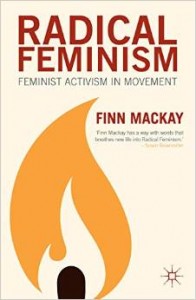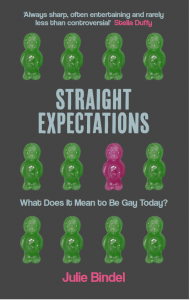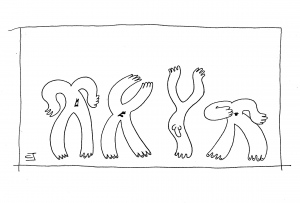How have we come to this? 1
Yasmin Rehman reviews Christine Delphy’s Separate and Dominate: Feminism and Racism after the War on Terror
The sociologist and theorist Christine Delphy has been one of the most influential figures in French feminism since the 1970s, when she was active in the Mouvement de libération des femmes (Women’s Liberation Movement), and co-founded the journal Nouvelles questions féministes with Simone de Beauvoir. Separate and Dominate is a collection of ten essays which she began writing in 1996. Originally published in French in 2008, this is the first English translation, and it contains an opening chapter written specifically for this volume.
I read the book in the midst of the fierce social media debate surrounding the Charlie Hebdo cartoon featuring Aylan Kurdi, in which those who criticised the satirical magazine for using an image of the dead toddler were accused of failing to understand satire and/or the French.[1] I was aware that my own lack of inside knowledge might affect my understanding: Delphy makes repeated reference to details of French governance, political controversies and pieces of legislation with which I am unfamiliar. But the issues and arguments raised by the book—terrorism, racism and imperialism, identity—are relevant and timely for British readers too.
I’ve taken the title of my review from a question Christine Delphy herself asks (p.65), though it has also been asked by politicians and policy-makers, academics, community activists, faith leaders and others in different parts of the world. With each terror attack in the West and each new report of Western-born Muslims and/or converts travelling to join Daesh (ISIS), the inevitable question is: how have we come to this?
Delphy’s aim, which she sets out in the opening sentences of the book, is ‘to elaborate a materialist approach to not only oppression and marginalization, but also domination and normality’ (p.1). She explores the way social divisions and hierarchies are constructed, and focuses on ‘the oppression of women, of non-whites and of gays’, which ‘divide the whole of society into two categories, two camps …. the Ones and the Others’. Domination relies on classification and separation in order to exert and retain power. Her objective is to demonstrate that hatred of the Other is not a natural, human trait but is socially constructed through concrete material practices, including ideological and discursive ones. She is interested in the way dominance operates and is imposed by the Ones, contrasting this with the ‘psychic suffering’ of the Others.
This juxtaposition of the dominant and the dominated is thought-provoking and challenging, but there are problems with Delphy’s binary opposition. It ignores the diversity that exists within both groups, and particularly among the ‘Others’.
Delphy suggests that Muslims in France are a homogenous group originating from former French colonies. She does not make reference to minorities within oppressed groups, or acknowledge differing cultural traditions (the Pew Forum estimates that there are 4.7 million Muslims in France, and whilst most hail from North Africa, there are also hundreds of thousands from the Indian sub-continent, Turkey and elsewhere bringing with them their own diverse experiences of Islam). She also fails to distinguish between Muslims, Islam and Islamism. She does not discuss Islamism as a political movement which has spread through communities across the world, nor the opposition to Islamism that exists within the same communities. As Karima Bennoune observes, we rarely hear ‘the perspectives of secular people of Muslim heritage concerned with both rising fundamentalism and increasing discrimination against Muslims’.
In Britain since the ‘Rushdie affair’ in 1989 (when the Ayatollah Khomeini issued a fatwa calling for the death of Salman Rushdie after the publication of his novel The Satanic Verses), there has been a shift away from identity categories based on racial, ethnic or national affiliation, and towards identities based on religious faith. South Asian communities in particular are now divided and identified along religious lines, and there has been a growing demand for more sensitivity to religious values, especially in the light of growing anti-Muslim racism. However, framing a feminist political response to these demands requires us, as Pragna Patel points out, to consider who defines ‘religious values’ and for what purpose. Although Delphy discusses the war on terror and its impact on Muslims living in the West, she glosses over the conservative, fundamentalist forces which may be at work within these same Muslim minority communities.
To veil or not to veil
Very few issues attract as much attention or public discussion as the niqab or face veil. Is it a symbol of oppression or of minority women asserting their religious identity? In 2004, when France became the first country in Europe to introduce legislation banning the wearing of religious symbols in schools, the law was initially presented as a matter of laïcité (state secularism) and what it means to be French. This ban in schools was later extended to wearing of the hijab in public spaces in 2007. It was followed by a ban on face coverings in 2011 based on security concerns. Delphy puts these events in the context of increasing anti-Muslim racism and growing support for the far right in France. She argues that banning the veil will further marginalise and isolate the very women and girls the State says it wishes to protect.
Other feminists take an opposing view. Marième Hélie-Lucas, an Algerian living in France, argues that
When talking of veils in schools, one automatically refers to the veiling of under-aged girls, i.e. not the veiling of women. The question thus becomes: who is to decide on girls’ veiling—themselves or the adults who are in charge of them? And which adults? This point requires special consideration given the new trend to veil girls as young as 5 as shown in the numerous campaigns going on now throughout North Africa.
Hélie-Lucas locates the debate about the hijab/niqab within a context that once applied to FGM and forced marriage. She asks, who is the adult in charge of protecting the girl-child’s rights? The state already plays this role when it prevents families from performing FGM on girls, or subjecting them to forced marriages. Why should it not also take responsibility for preventing the deep psychological damage induced by wearing a veil before adulthood? Why should the state be seen as authoritarian when it prevents the veiling of girls but not when it protects them from FGM? In the 1970s in Europe and North America there were many on the Left, as well as some feminists, who defended FGM as a ’cultural right’ and denounced efforts to eradicate the practice in Europe as ‘western imperialism’. At no point was any reference made to the struggles of women on the ground to eradicate FGM in parts of Africa. We see the same pattern replicated regarding the ‘right to veil’, which is now seen as a ‘religious right’ despite the fact that numerous progressive interpreters of the Qur’an have stated that it is not an Islamic injunction.
Delphy accuses feminists who support the ban of failing Muslim women by supporting racist laws. She also criticises organisations like Ni Putes Ni Soumises (‘neither whores nor submissive women’), which was established by Fadela Amara—an activist with roots in the anti-racist organization SOS Racisme—to break the silence about violence against Muslim women in French immigrant communities. She commends the group for challenging sexism but accuses it of supporting a racist agenda in order to secure government funds (p.154). This attack on minority women makes me deeply uncomfortable. Delphy fails to recognise the very real risks minority women face when they challenge violence against women and girls and the power structures within their communities. Why should the government not fund organisations to protect those at risk of violence and abuse?
The veil is only the latest example of men in minority communities using the imposition of traditional/religious dress codes to control women and girls. Many South Asian women and girls have spoken in the past about being forced to wear shalwar kameez in order to maintain modesty and conform to community norms. Over the years schools in many areas adjusted their uniform policy to allow the wearing of trousers for girls and/or shalwar kameez in school colours. This accommodation to community dress code demands later incorporated the hijab/ headscarf, but not the face veil.
In 2002 Shabina Begum, a young Muslim girl, took legal action against her school for refusing her permission to wear the jilbab (full ankle-length dress). She claimed that this breached her human right to manifest her religion, and also her right to an education, since she was barred from the school unless she complied with its uniform policy. In 2006 the House of Lords delivered a judgement stating that Shabina’s rights had not been violated, and that any infringement was necessary and proportionate for the protection and well-being of the wider school community. The judges stated that school’s uniform policy already took account of ‘mainstream’ Muslim opinion.
According to Pragna Patel, this decision reflected an understanding of the political context: Shabina’s challenge had been motivated by the desire of others to impose a politicized religious identity on women and girls at the school. Shabina was represented by her older brother, who appeared to be part of an extreme Muslim political group. The group had protested outside the school—not against the uniform policy, but against the education of Muslim children in secular schools.
However, some feminists, like Maleiha Malik, criticised the judgement for failing to recognise that Shabina was exercising her autonomy by wearing the jilbab in an environment where Muslims are constantly demonised and discriminated against. Like Delphy, Malik located the debate primarily in relation to the issue of anti-Muslim racism. But what both overlook is that for a woman to wear the veil is not necessarily an act of individual agency, but is profoundly shaped by political processes that involve the privileging of a religious identity over others.
This is not to deny that Muslim women may wear the veil by choice. Muslim women themselves have talked about wearing the hijab or niqab as a visible symbol of their religious identity, or to protect themselves from male attention and aggression. As Mona Eltahawy says in her book Headscarves and Hymens, the act of wearing the hijab is far from simple. But let us not forget that some Muslim women face violence and abuse for daring to challenge community norms justified by so-called codes of honour. Both Eltahawy and Aliyah Saleem, an ex-Muslim and former student at an Islamic school, have written about their experiences of being forced to wear the hijab. Aliyah has recently produced a series of videos discussing the challenges she faced when she decided to remove her hijab.
The veil continues to be a source of challenge in both Muslim majority and minority contexts. There is a long tradition of Muslim academics and theologians offering feminist interpretations of Qur’anic verses including references to the veil. The late Fatima Mernissi, a leading Moroccan sociologist and feminist, Leila Ahmed, an Egyptian American scholar, and Amina Wadud are among the women who have argued that the Qur’an prescribes modesty, and not specifically veiling. Delphy, however, makes no reference to these arguments.
Racism, Identity and the War on Terror
Like the debate on the hijab, discussions of the ‘war on terror’ are polarised, with neither side moving towards the other. Are there only two positions? Must we either support the war on terror and recognise the Islamist threat, or else maintain that the war on terror is a war against Islam and an excuse to demonize Muslims?
It would appear that the French Left, like its British equivalent, views terrorism as the result of imperialist interventions in Iraq and elsewhere, or as a result of earlier injustices during the period of colonial rule. Yet the first of these arguments seems unconvincing in relation to France, which opposed the war in Iraq but has still seen terror unleashed on the streets of Paris. If we accept the argument that terrorism and violence are a response to the West’s attacks on Muslims, then as a strategy I would argue it has failed spectacularly. Every act of terrorism, from the bombings of American targets in the 1980s and 1990s to the recent killings in Paris and Brussels, has prompted increased military action by the West and its allies, resulting in further loss of Muslim lives. In the West it has led to increased surveillance of Muslims, fuelled the growth of anti-Muslim racism and promoted the rise of the far Right.
In the context of increasing anti-Muslim hatred and discrimination it is incredibly difficult to raise concerns about political Islamist movements, violations of human rights by Islamists or the oppression of Muslim women, without feeding an anti-Muslim discourse. In Double Bind: the Muslim Right, the Anglo-American Right and Universal Human Rights, Meredith Tax asks:
When US diplomats invoke the oppression of Muslim women to sanctify war, how do we practice feminist solidarity without strengthening Orientalism and neo-colonialism? When the US targets jihadis for assassination by drone, should human rights defenders worry about violations perpetrated those same jihadis or focus on violations by the State?
Conversely, how does one raise the points discussed by Delphy with regard to the war on terror, drone strikes, Guantanamo, and the denial of any discussion about the real or perceived causes for terrorism, without feeding the Islamist agenda and reinforcing the Muslim victim narrative?
In her discussion of Guantanamo Bay, Delphy is right to denounce the utter lack of due process and the incarceration of prisoners without charge, but I disagree with her claim that ‘their only crime is to be of Arab origin or Muslim faith’. The reality is more complex: it is possible to be both a victim of injustice and a supporter of terrorism. Delphy’s portrayal of French Muslims as passive victims of discrimination and prejudice—the Others dominated by the Ones—repeats the very same argument propagated by Islamists. It could be asked whether this helps to give credibility to the Islamist narrative—a narrative which is strongly contested in Muslim majority countries, as Karima Bennoune and others have shown.
Delphy identifies the centrality of racism to a construction of Muslim Others as backward, patriarchal and oppressive. That racism is fuelled on a daily basis by media portrayals of Muslims as oppressed women, rapists, terrorists, child abusers, illegal immigrants and benefits cheats. However, it is also unhelpful to deny that some people in Muslim communities do fall into those categories. To move forward, we need a more open and honest debate, including women and men, those of faith and of no faith, whites and non-whites, gay and straight people and all minority groups. We should heed the call to action with which Separate and Dominate ends:
We all need to revisit our way of thinking about the articulation and imbrication of patriarchy and racism, as well as the way we ‘do’ activism. The feminist movement cannot survive unless it becomes truly universal, taking all women, all their situations and all their revolts into account.
[1] The cartoon shows Aylan Kurdi – the child whose picture, lying face down on a beach, highlighted the refugee crisis – with a message “What would have happened to little Aylan if he grew up?” The answer, “A groper of women in Germany.” Under the headline “Migrants”, the cartoon shows two men with their tongues out and arms outstretched running behind a woman. It clearly alludes to the recent incident in Cologne, Germany where mass sexual assaults were reported on New Year’s Eve, allegedly perpetrated by refugees.
Christine Delphy, Separate and Dominate: Feminism and Racism after the War on Terror, translated by David Broder, published by Verso Books, 2015.
Find Yasmin Rehman on Twitter @RehmanYasmin



